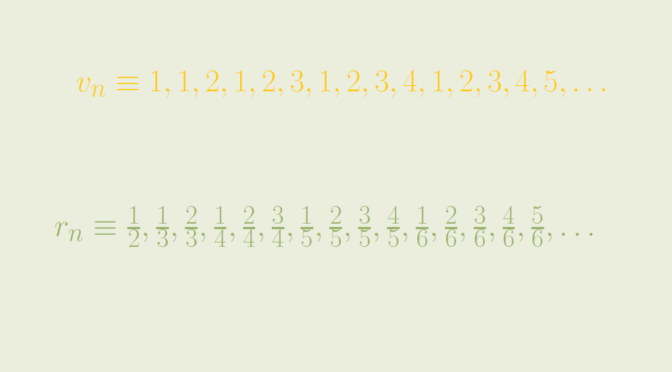Let’s start by recalling an important theorem of real analysis:
THEOREM. A necessary and sufficient condition for the convergence of a real sequence is that it is bounded and has a unique limit point.
As a consequence of the theorem, a sequence having a unique limit point is divergent if it is unbounded. An example of such a sequence is the sequence \[
u_n = \frac{n}{2}(1+(-1)^n),\] whose initial values are \[
0, 1, 0, 2, 0, 3, 0, 4, 0, 5, 6, \dots\] \((u_n)\) is an unbounded sequence whose unique limit point is \(0\).
Let’s now look at sequences having more complicated limit points sets.
A sequence whose set of limit points is the set of natural numbers
Consider the sequence \((v_n)\) whose initial terms are \[
1, 1, 2, 1, 2, 3, 1, 2, 3, 4, 1, 2, 3, 4, 5, \dots\] \((v_n)\) is defined as follows \[
v_n=\begin{cases}
1 &\text{ for } n= 1\\
n – \frac{k(k+1)}{2} &\text{ for } \frac{k(k+1)}{2} \lt n \le \frac{(k+1)(k+2)}{2}
\end{cases}\] \((v_n)\) is well defined as the sequence \((\frac{k(k+1)}{2})_{k \in \mathbb N}\) is strictly increasing with first term equal to \(1\). \((v_n)\) is a sequence of natural numbers. As \(\mathbb N\) is a set of isolated points of \(\mathbb R\), we have \(V \subseteq \mathbb N\), where \(V\) is the set of limit points of \((v_n)\). Conversely, let’s take \(m \in \mathbb N\). For \(k + 1 \ge m\), we have \(\frac{k(k+1)}{2} + m \le \frac{(k+1)(k+2)}{2}\), hence \[
u_{\frac{k(k+1)}{2} + m} = m\] which proves that \(m\) is a limit point of \((v_n)\). Finally the set of limit points of \((v_n)\) is the set of natural numbers.
A sequence whose set of limit points is the segment \([0,1]\)
Taking advantage of the sequence \((v_n)\), let’s now consider \((r_n)\) whose initial terms are \[
\frac{1}{2}, \frac{1}{3}, \frac{2}{3}, \frac{1}{4}, \frac{2}{4}, \frac{3}{4}, \frac{1}{5}, \frac{2}{5}, \frac{3}{5}, \frac{4}{5}, \frac{1}{6}, \frac{2}{6}, \frac{3}{6}, \frac{4}{6}, \frac{5}{6}, \dots\] Formal definition of \((r_n)\) is \[
r_n=\begin{cases}
\frac{1}{2} &\text{ for } n= 1\\
\frac{n}{k+2} – \frac{k(k+1)}{2(k+2)} &\text{ for } \frac{k(k+1)}{2} \lt n \le \frac{(k+1)(k+2)}{2}
\end{cases}\] The values of the sequence \((r_n)\) are in \((0,1) \cap \mathbb Q\). Moreover, one can notice that \((r_n)\) takes each rational number of \((0,1)\) as value an infinite number of times. Indeed for \(\frac{p}{q} \in (0,1)\) with \(1 \le p \lt q\) and \(m \ge 1\) we have \[
\frac{(mq-2)(mq-1)}{2} \lt \frac{(mq-2)(mq-1)}{2} + mp\] and \[\begin{aligned}
\frac{(mq-2)(mq-1)}{2} + mp &\le \frac{(mq-2)(mq-1)}{2} + m(q-1)\\
&\le \frac{(mq-2)(mq-1)}{2} + mq-1\\
&= \frac{(mq-1)mq}{2}
\end{aligned}\] Hence \[\begin{aligned}
r_{\frac{(mq-2)(mq-1)}{2} + mp} &= \frac{(mq-2)(mq-1)}{2mq} + \frac{mp}{mq} – \frac{(mq-2)(mq-1)}{2mq}\\
&= \frac{mp}{mq}\\
&= \frac{p}{q}
\end{aligned}\] proving the desired result. As the rational numbers of the segment \((0,1)\) are dense in \([0,1]\), we can conclude that the set of limit points of \((r_n)\) is exactly the interval \([0,1]\).
A sequence whose set of limit points is \(\mathbb R\)
Consider the real function \[
\begin{array}{l|rcll}
f : & (0,1) & \longrightarrow & \mathbb R\\
& x & \longmapsto & \frac{2x-1}{x(1-x)} \end{array}\] One can verify that \(f\) is continuous, strictly increasing and \[
\lim\limits_{x \to 0^+} f(x) = -\infty, \ \lim\limits_{x \to 1^-} f(x) = +\infty.\] Therefore \(f\) is a bijection from \((0,1)\) onto \(\mathbb R\). We claim that the set of limit points of the rational sequence \((f(r_n))\) is \(\mathbb R\).
For \(y_0 \in \mathbb R\), let’s take the unique \(x_0 \in (0,1)\) such that \(f(x_0)=y_0\). As the set of limit points of \((r_n)\) is \([0,1]\), one can find a subsequence \((r_{j(n)})\) converging to \(x_0\). \(f\) being continuous, the sequence \((f(r_{j(n)}))\) converges to \(f(x_0)=y_0\), concluding our proof.


One thought on “Limit points of real sequences”